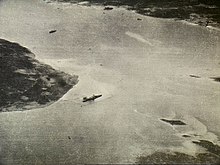| Operation Obviate | |||||||
|---|---|---|---|---|---|---|---|
| Part of World War II | |||||||
 Tirpitz at her mooring off the island of Håkøya in November 1944 | |||||||
| |||||||
| Belligerents | |||||||
|
|
| ||||||
| Commanders and leaders | |||||||
|
|
| ||||||
| Strength | |||||||
| 39 Avro Lancasters |
Battleship Tirpitz 2 flak ships Anti-aircraft batteries | ||||||
| Casualties and losses | |||||||
| 1 aircraft |
Minor damage to Tirpitz 3 injured | ||||||
Operation Obviate was an unsuccessful British air raid of World War II which targeted the German battleship Tirpitz. It was conducted by Royal Air Force heavy bombers on 29 October 1944, and sought to destroy the damaged battleship after she moved to a new anchorage near Tromsø in northern Norway.
The attack followed up the successful Operation Paravane on 15 September 1944, when Tirpitz was crippled by British heavy bombers. As Allied intelligence was unaware that the battleship could no longer operate at sea and warships needed elsewhere were being retained in British waters to counter her, it was decided to make another attack. After a period of planning and preparations, 38 British bombers and a film aircraft departed from bases in northern Scotland during the early hours of 29 October. The attack took place that morning, but was frustrated by clouds over the Tromsø area which made it difficult for the Allied airmen to accurately target Tirpitz. The battleship was not directly hit, but was damaged by a bomb that exploded near her hull. A British bomber made a crash landing in Sweden after being hit by German anti-aircraft fire, and several others were damaged.
The Allies remained committed to sinking Tirpitz after the failure of Operation Obviate. The plans for the attack were reused for the next raid on the battleship, Operation Catechism, which took place on 12 November 1944. Weather conditions were favourable for the attackers, and Tirpitz was sunk with heavy loss of life.
- ^ Bishop 2012, pp. 339, 341.
